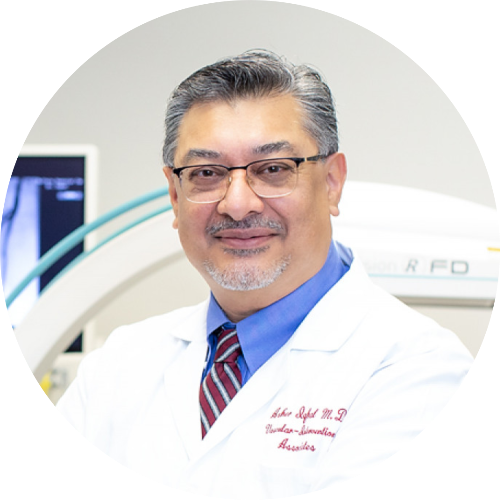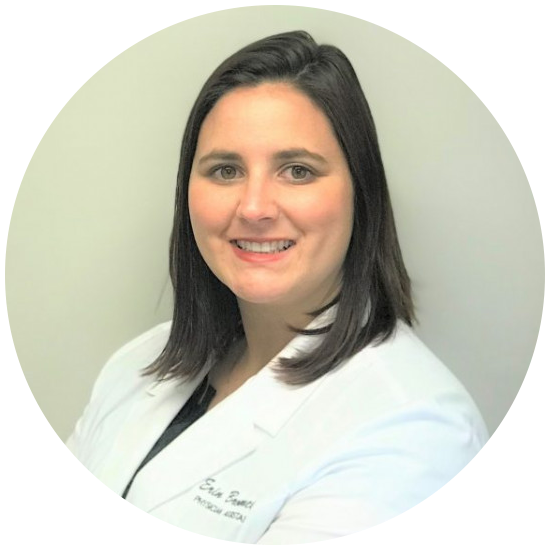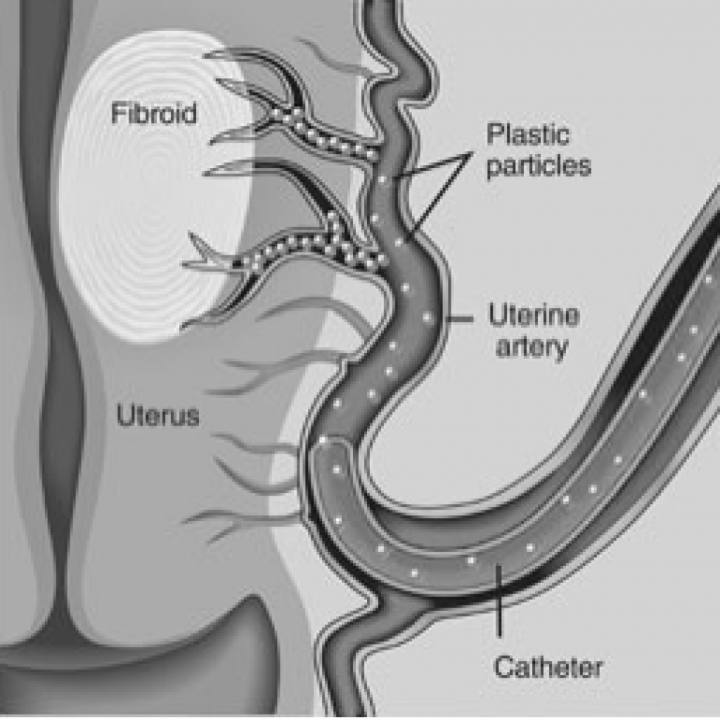Uterine Artery / Fibroid Embolization
Fibroids can be treated without surgery / hysterectomy!
Are you suffering from any of these symptoms?
- Excessive bleeding and menstrual cramps
- Prolonged menstrual periods
- Pelvic pressure or pain
- Frequent urge to urinate
- Constipation
Request an appointment today to discuss your nonsurgical solution to treating uterine fibroids and adenomyosis.
Many women are offered treatments such as hysterectomy or myomectomy that require surgery and hospital stay.
Buffalo Vascular Care offers Uterine Artery Embolization – a safe, non-surgical solution to treating Uterine Fibroids and Adenomyosis performed in the comfort of our centrally located outpatient facility.
Notes From Our Team On Uterine Fibroids

Azher Iqbal, MD
“When suffering with fibroids or adenomyosis you want to see an experienced and compassionate care team who can answer all your questions, concerns and work with your existing GYN/medical provider.
I am a board certified vascular interventional radiologist, I have performed UAE for close to 20 years. Our clinical team has brought consistent innovations to interventional women’s health management in our region.
We will explain the procedure as well as any other alternatives available to you. We are dedicated to patient care and trust.
Let the UAE expert team at BVC help you to a speedy recovery!”
Erin Paone, RPA-C
“Uterine fibroids and adenomyosis can negatively affect your quality of life, and cause you to live suffering.
Buffalo Vascular Care is an innovative, outpatient facility that delivers high quality care. During your office visit with us we will review all treatment options for fibroids, including non-surgical procedures such as Uterine Artery Embolization (UAE) that is offered right in the comfort of our office based lab, and we will answer all of your questions. We focus on patient education so you can make informed decisions regarding treatment for your fibroids.”


Tiffany Card, PA-C
“For years, women with uterine fibroids and adenomyosis have been told that successful treatment would involve hysterectomy. It’s been a well-kept secret that there is, in fact, another option besides a hysterectomy to successfully treat these issues. At Buffalo Vascular Care, it is our mission to not only treat these women with a safe, non-surgical, minimally invasive solution, but to spread the word about Uterine Artery Embolization, so it is no longer a well-kept secret and more women can benefit from this state of the art treatment. Our facility is equipped to evaluate you at your first appointment and ultimately perform the procedure right on site, avoiding hospitalization.”
Overview of Uterine Artery Embolization (UAE)
Learn about the process, outcomes, and benefits.
What is the process for UAE?
This is a minimally invasive, non surgical procedure, done in an outpatient setting outside of the hospital. A catheter is passed through a small puncture in the wrist, advancing to the uterine arteries using live X-ray. Tiny particles are then released into the artery that supplies blood to the uterus, cutting off blood flow to the fibroids and adenomyosis tissue, ultimately shrinking it.
What are the Outcomes/Expectations?
90% of women who undergo this procedure have significant relief of heavy bleeding, pain, and other symptoms. This procedures allows women to be released home the same day of the procedure, and they are typically able to return to work within 1 week. UAE is a very safe procedure, it is approved by the FDA and complication rates are less than 1%, lower than hysterectomy and myomectomy.
What are the benefits of UAE?
- Requires no hospitalization unlike hysterectomy or myomectomy
- High patient satisfaction
- Preservation of the uterus
- Minimal blood loss compared to surgery
- Small puncture in wrist instead of an incision
- Covered by most insurance companies
Doctor Breaks Down What Women Need To Know About Fibroids
Frequently Asked Questions
During the first 2-4 hours you may experience mild to intense cramping and nausea. You will be given medications during recovery to make you feel comfortable.
During the first 2-4 hours you may experience mild to intense cramping and nausea. You will be given medications during recovery to make you feel comfortable.
After the first 4-10 hours, cramping will subside to mild or moderate pain typically lasting 1-5 days. Flu-like symptoms like a low-grade fever, low appetite, aches, and mild nausea can occur. You will be provided with medications for pain and nausea to take at home.
Most women will experience relief of heavy menstrual bleeding as soon as their first menstrual cycle after the procedure. Treated fibroids may take six months to shrink which will relieve symptoms of back pain, bloating, constipation, and frequent urination.
Although UFE is very safe and less risky than surgery, all medical procedures have potential risks. In a very small number of cases, the fibroids and uterus become infected. This can usually be controlled with antibiotics, but sometimes a hysterectomy may be required. A small number of patients have reported beginning menopause after the procedure, but this rarely occurs in women under the age of 45 and is most common in older women who are approaching menopause.
UFE is a non-surgical procedure performed in an outpatient facility. Most women go home 2-4 hours after the procedure. Majority of women return to work in 5-10 days.
The success rate for UFE is 95%.
After a UFE procedure the fibroid tumors shrink over 6-12 month period and become scar tissue.
Yes, UFE is covered by most insurance plans.
UFE is a specialized procedure performed by an interventional radiologist. Most gynecologist do not have the additional training and equipment necessary to perform the procedure.
WHAT OUR
Patients Are Saying
“The staff goes out of their way to assist, answer any questions, and make you feel comfortable. Professional, capable, pleasant.”
Sharon M.
“Treatment has enabled me to want to leave my house and enjoy life again- I can now walk, standup, or sit without constant pain. I was pleased with the polite & professional care. I would recommend Dr. Iqbal to anyone.”
Helen D.
“I recently had the uterine fibroid embolization performed by Dr. Azher Iqbal at Buffalo Vascular Care. It has been made apparent by both Dr. Iqbal and his staff’s actions that the patient is number one. Clearly, this is a highly professional, friendly, efficient team that works cohesively for the total well being of the patient.”
Suzanne P.

